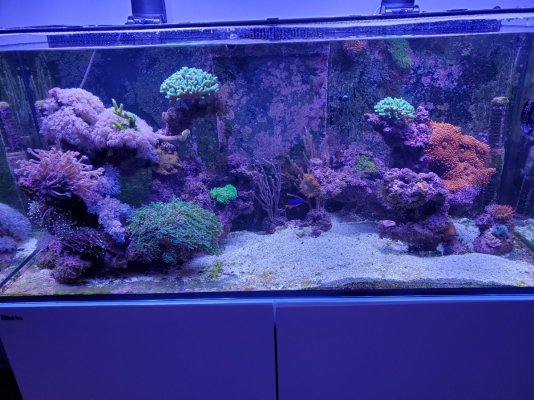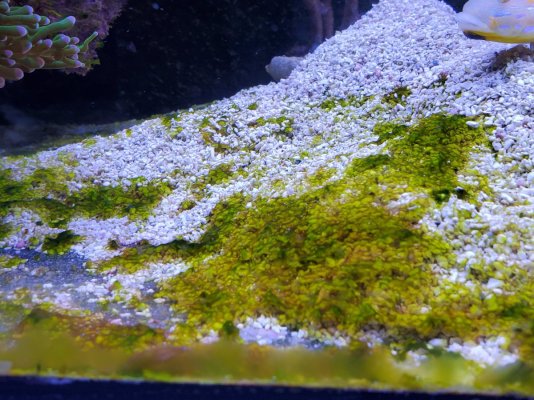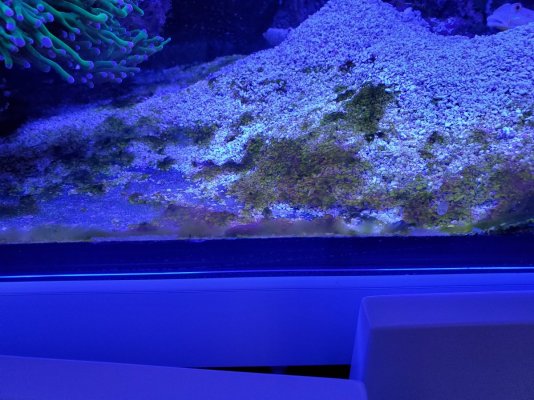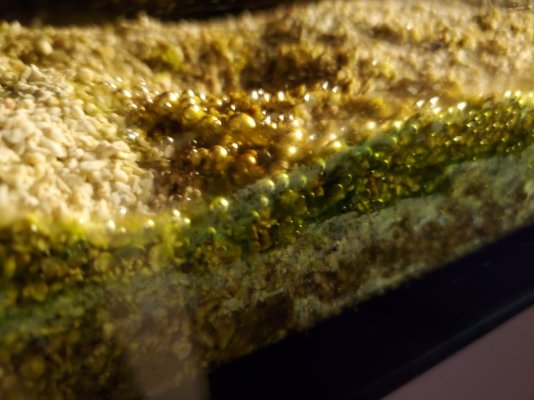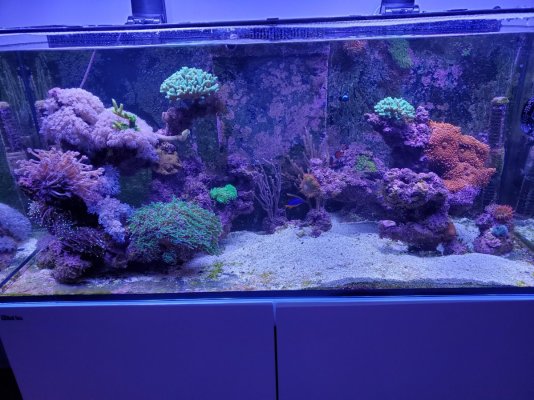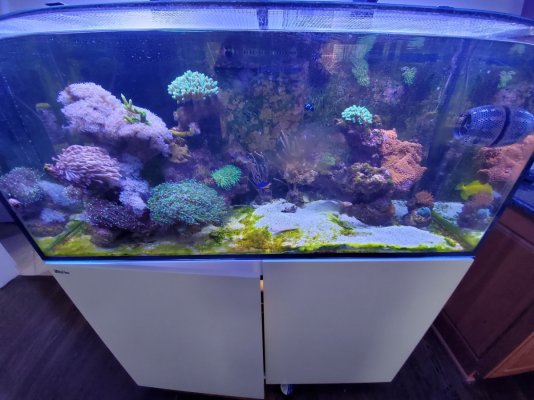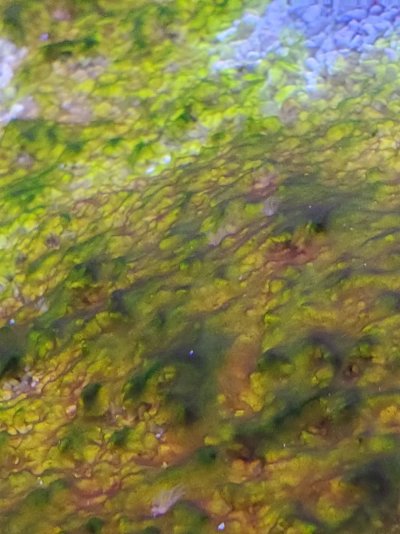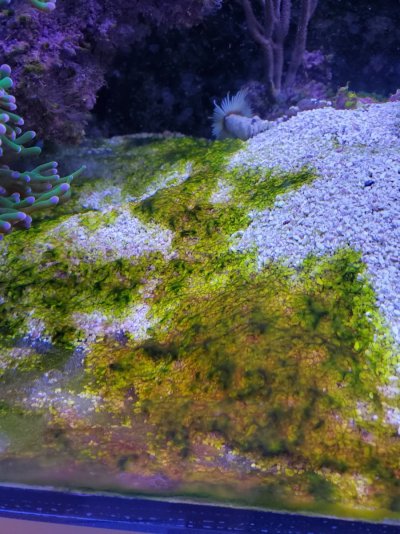- Joined
- Jun 10, 2017
- Messages
- 332
- Reaction score
- 128
Hello everyone,
I have been reefing for 15 years, but took a decade long break when I went into the military. In the past I have always worked with live rock for my systems or clients systems when I was a young teenage kid and running a small fish business lol. This was the first tank I ever used dry, sterile rock. I wanted to share my success with the beginners in the hobby and give a complete breakdown of my ongoing battle with cyano that I am FINALLY getting under control.
Tank Specs & Specimens:
210 gallon system (150 gallon & 60 gallon sump)
Vectra M2 return pump
(2) MP40 power heads
Reef Octopus internal skimmer, rated for 300+ gallons
Approx 80lbs of dry Marco rock in display and in sump
(2) Neptune Sky LED lights
Livestock:
Juvenile orange shoulder tang
Pair of bullet hole clowns
Royal Gramma
Helfrichi
(10) masked gobies
(3) bimaculatus anthias
(3) neon blue gobies
(1) twin spot goby
(1) blood shrimp
(1) sand sifting starfish
(2) fighting conches
(1) crocea clam
(3) gorgonians
(40-50) snails: wide assortment of every kind from giant mexican turbo snails, to tiny nessariius snails & cerith snails
(1) blue knuckle crab
(1) halloween crab
(18-20) blue legged & red legged crabs
Corals:
(4) designer torches
(1) SPS stick
(1) bubble coral
(6) euphyllia ranging from hammers to octospawns and frogspawn
(1) trachy
(1) scoly
(2) blastos
(3) monti caps & 1 digitata
(1) duncan
(2) trumpets
(15) zoas
(4) mushrooms
My tank was setup in May of last year and finished cycling by end of June. Small bacteria blooms would come and go, as well as cyano itself, and other "ugly phase" algae. Things got really bad mid-December when I had cyano completely blow up. At first I let it be as it did come and go in the past, but after 3 weeks of it not going away and getting worse, I had to step things up.
I did a TON of research and reading and asking questions here. Before I proceed, I'd like to make a shoutout to the following people for helping me along the way @vetteguy53081 @Lavey29 @SunnyX @Randy Holmes-Farley
Although their knowledge was instrumental in assisting with this issue, not all of their suggestions worked. All tanks are different; what works for one person, might not work for another. I will share what worked for me and what did not. Please note** I am a naturalist. I do not ever use chemical bombs to treat an issue in the tank. If the ocean has natural ways to defeat an issue, so can we.
What DID NOT work for me:
-Turning off protein skimmer for 12 hours a day in hopes to increase nutrient levels.
-Vacuuming cyano off sand bed. The cyano was so thick, all I was doing was pulling out a ton of sand.
-Changing out filter socks as often as possible
-Microbacter 7
-3 day blackout periods
-Reducing the intensity of lights across all spectrums
What DID work for me:
-Dosing nitrates to consistently keep levels at 10ppm (corals also looked happier)
-Using SunnyX's technique shown here https://www.reef2reef.com/threads/extreme-water-clarity-and-cyano-eradication-made-easy.916381/ I replaced the microbacter 7 with microbacter clean and dosed every other day. When dosing with MB clean, I followed the instructions exactly, along with Sunny's instructions, and let the mixture sit for 30 minutes to let the bacteria adhere to the calcium carbonate. I turned off protein skimmer and return pump for 4 hours, but kept the power heads on and dosed right into tank. After 15 minutes of letting the powerheads blow around the bacteria laced calcium carbonate, I turn them off for an hour to allow the mixture to settle on the rocks, glass, & sand bed. After the hour is up, I turn the powerhead on for an additional 3 hours. After this point, I now turn on the return pump and skimmer.
-Added a massive amount of amphipods and copepods to the system on 15 JAN
-Weekly water changes of 25%, increased from 10-15%
-Turn the protein skimmer on full blast
-Increase the MP40's speed by 15 during the nutrient transport cycle
The most noticeable change of the cyano starting to die off is:
-Dosing 4 tablespoons of phytoplankton every other day to increase the population of beneficial bacteria & increase pod populations (pods do not eat cyano, but are a fantastic CUC. They help to eradicate uneaten foods, that will raise phosphates over time, aiding in cyano growth).
Lessons learned from this experience:
1) I am fortunate to be self-employed and have all the time in the world to monitor corals during this outbreak. However, even with this dedication I still lost a handful of zoa's, 1 acan, 1 black widow anemone, and a LOT of snails. Within the first year of a sterile tank setup, I will add corals very slowly.
2) I will never do another blackout, I have no doubt the combination of cyano smothering my corals and reducing their food source has contributed to their demise.
3) I will never use MB7 again to help fight cyano. MB Clean is the clear winner by a mile.
4) I will never setup a dry, sterile system ever again without putting in live rock in the sump (from a sustainable source, obviously). The lack of bacteria in the system is asking for trouble down the line.
I really hope this helps everyone out and good luck in your cyano battles!
Tank in December: https://www.reef2reef.com/threads/cyano-calcium-carbonate.958991/#post-10945590
Tank now:
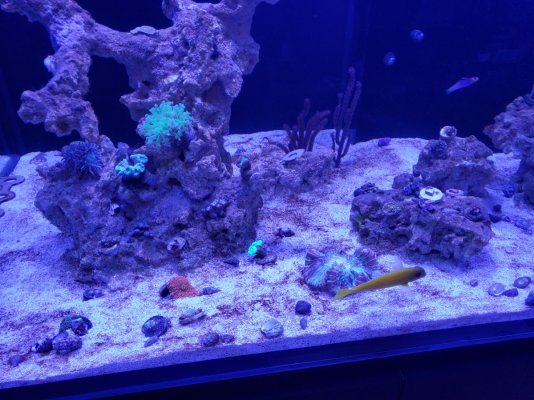
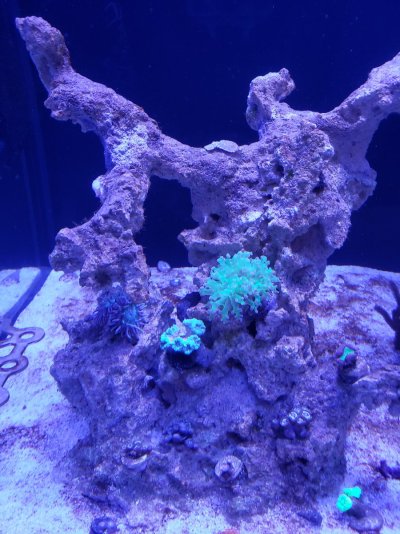
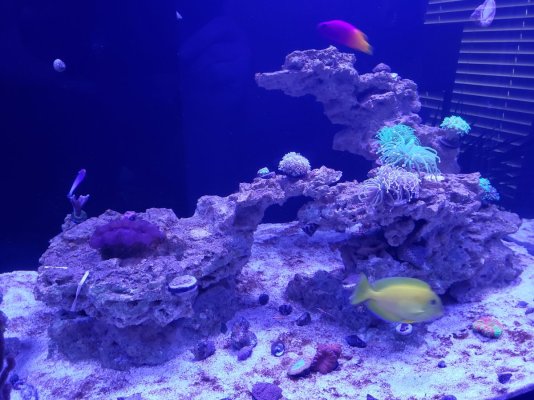
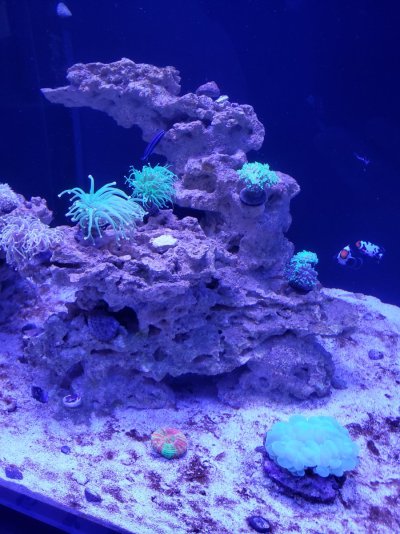
I have been reefing for 15 years, but took a decade long break when I went into the military. In the past I have always worked with live rock for my systems or clients systems when I was a young teenage kid and running a small fish business lol. This was the first tank I ever used dry, sterile rock. I wanted to share my success with the beginners in the hobby and give a complete breakdown of my ongoing battle with cyano that I am FINALLY getting under control.
Tank Specs & Specimens:
210 gallon system (150 gallon & 60 gallon sump)
Vectra M2 return pump
(2) MP40 power heads
Reef Octopus internal skimmer, rated for 300+ gallons
Approx 80lbs of dry Marco rock in display and in sump
(2) Neptune Sky LED lights
Livestock:
Juvenile orange shoulder tang
Pair of bullet hole clowns
Royal Gramma
Helfrichi
(10) masked gobies
(3) bimaculatus anthias
(3) neon blue gobies
(1) twin spot goby
(1) blood shrimp
(1) sand sifting starfish
(2) fighting conches
(1) crocea clam
(3) gorgonians
(40-50) snails: wide assortment of every kind from giant mexican turbo snails, to tiny nessariius snails & cerith snails
(1) blue knuckle crab
(1) halloween crab
(18-20) blue legged & red legged crabs
Corals:
(4) designer torches
(1) SPS stick
(1) bubble coral
(6) euphyllia ranging from hammers to octospawns and frogspawn
(1) trachy
(1) scoly
(2) blastos
(3) monti caps & 1 digitata
(1) duncan
(2) trumpets
(15) zoas
(4) mushrooms
My tank was setup in May of last year and finished cycling by end of June. Small bacteria blooms would come and go, as well as cyano itself, and other "ugly phase" algae. Things got really bad mid-December when I had cyano completely blow up. At first I let it be as it did come and go in the past, but after 3 weeks of it not going away and getting worse, I had to step things up.
I did a TON of research and reading and asking questions here. Before I proceed, I'd like to make a shoutout to the following people for helping me along the way @vetteguy53081 @Lavey29 @SunnyX @Randy Holmes-Farley
Although their knowledge was instrumental in assisting with this issue, not all of their suggestions worked. All tanks are different; what works for one person, might not work for another. I will share what worked for me and what did not. Please note** I am a naturalist. I do not ever use chemical bombs to treat an issue in the tank. If the ocean has natural ways to defeat an issue, so can we.
What DID NOT work for me:
-Turning off protein skimmer for 12 hours a day in hopes to increase nutrient levels.
-Vacuuming cyano off sand bed. The cyano was so thick, all I was doing was pulling out a ton of sand.
-Changing out filter socks as often as possible
-Microbacter 7
-3 day blackout periods
-Reducing the intensity of lights across all spectrums
What DID work for me:
-Dosing nitrates to consistently keep levels at 10ppm (corals also looked happier)
-Using SunnyX's technique shown here https://www.reef2reef.com/threads/extreme-water-clarity-and-cyano-eradication-made-easy.916381/ I replaced the microbacter 7 with microbacter clean and dosed every other day. When dosing with MB clean, I followed the instructions exactly, along with Sunny's instructions, and let the mixture sit for 30 minutes to let the bacteria adhere to the calcium carbonate. I turned off protein skimmer and return pump for 4 hours, but kept the power heads on and dosed right into tank. After 15 minutes of letting the powerheads blow around the bacteria laced calcium carbonate, I turn them off for an hour to allow the mixture to settle on the rocks, glass, & sand bed. After the hour is up, I turn the powerhead on for an additional 3 hours. After this point, I now turn on the return pump and skimmer.
-Added a massive amount of amphipods and copepods to the system on 15 JAN
-Weekly water changes of 25%, increased from 10-15%
-Turn the protein skimmer on full blast
-Increase the MP40's speed by 15 during the nutrient transport cycle
The most noticeable change of the cyano starting to die off is:
-Dosing 4 tablespoons of phytoplankton every other day to increase the population of beneficial bacteria & increase pod populations (pods do not eat cyano, but are a fantastic CUC. They help to eradicate uneaten foods, that will raise phosphates over time, aiding in cyano growth).
Lessons learned from this experience:
1) I am fortunate to be self-employed and have all the time in the world to monitor corals during this outbreak. However, even with this dedication I still lost a handful of zoa's, 1 acan, 1 black widow anemone, and a LOT of snails. Within the first year of a sterile tank setup, I will add corals very slowly.
2) I will never do another blackout, I have no doubt the combination of cyano smothering my corals and reducing their food source has contributed to their demise.
3) I will never use MB7 again to help fight cyano. MB Clean is the clear winner by a mile.
4) I will never setup a dry, sterile system ever again without putting in live rock in the sump (from a sustainable source, obviously). The lack of bacteria in the system is asking for trouble down the line.
I really hope this helps everyone out and good luck in your cyano battles!
Tank in December: https://www.reef2reef.com/threads/cyano-calcium-carbonate.958991/#post-10945590
Tank now:




Last edited:






